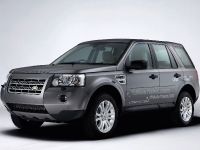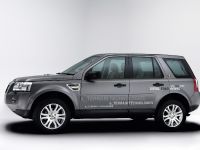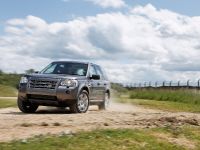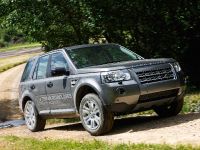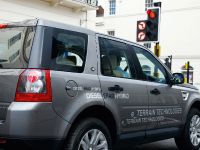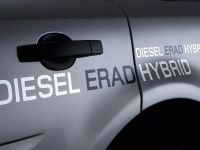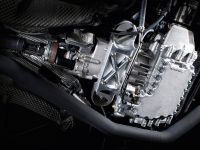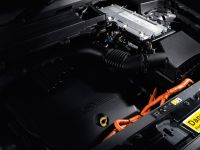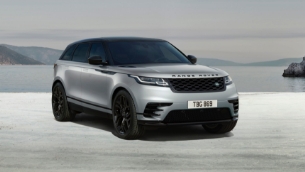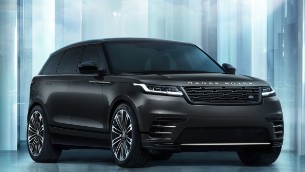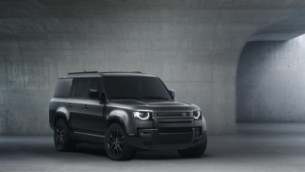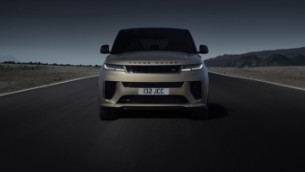Land Rover's Diesel ERAD Hybrid & e_TERRAIN TECHNOLOGIES
Land Rover's engineers are now conducting real-world tests with some ground-breaking Diesel ERAD Hybrid vehicles, aimed at dramatically cutting CO2 and other emissions while still delivering characteristic Land Rover all-terrain performance. These engineering ‘mules' are based on Freelander 2 vehicles, but the technology is designed to be scalable and modular, so could be applied across a variety of Land Rover models and powertrains.
This programme is one of a broad range of sustainability-focused engineering programmes that Land Rover is pursuing, brought together by the company under the collective name e_TERRAIN TECHNOLOGIES.
In addition to these Diesel ERAD Hybrids, Land Rover is developing a range of other emissions-busting and fuel-saving technologies that will start appearing on its production vehicles from now and over the next decade. These range from a stop-start function – which will be available next year as standard on all manual diesel Freelander 2 models – to other advanced hybrid systems and lightweight vehicle architectures.
"Our innovative ERAD technology featured in the LRX concept car unveiled earlier this year, and we're now starting to deliver on our sustainability commitments with full, on-road prototypes," says Phil Popham, Land Rover's Managing Director. "These Diesel ERAD Hybrids mark a crucial point for Land Rover, where engineering concept is seen to become reality and our vehicles start to combine their formidable all-terrain capability with our radical new e_TERRAIN TECHNOLOGIES."
Diesel ERAD Hybrid overview
Land Rover's Diesel ERAD Hybrid was developed as part of a multi-million-pound project supported by the UK Government's Energy Saving Trust, under the low carbon research and development programme. The objective is to develop a ‘parallel' hybrid drive system compatible with all-terrain four-wheel-drive capability. As parallel hybrids, the vehicles can be driven solely by electric power or by the diesel engine, or by a combination of both. The system is designed to reduce CO2 by more than 20 per cent under the NEDC test cycle and to cut it by a substantial 30 per cent in ‘real-life' urban conditions where hybrid technologies really come into their own.
Under many circumstances, today's generation of petrol electric hybrids are little more efficient than the best modern diesel engines without hybrid technology. So Land Rover's ambition is to add the benefits of a full hybrid system to modern, clean and efficient diesel powertrains, giving a win-win situation. To help deliver this, Land Rover has developed its own, unique Electric Rear Axle Drive (ERAD) system, which actually has the potential to enhance the vehicle's all-terrain capability.
Crucially, the ERAD would enable a Land Rover to run on electric power alone, a feature which is especially effective for reducing emissions in urban conditions. Though mounted on the rear axle, the ERAD can deliver power to the front wheels, via the propshaft, enabling it to drive the vehicle in full four-wheel drive.
The second key technology on the Diesel ERAD Hybrid prototypes is the Crankshaft Integrated Starter Generator (CISG), which works with the four-cylinder turbodiesel engine of the Freelander 2 prototype mules. The CISG is a powerful electric unit mounted within the special dual-clutch transmission fitted to the prototypes. It acts as a supplementary motor for adding torque to the driveline and also for starting the main diesel engine.
The engine, CISG and ERAD work together to deliver the hybrid drive, providing a choice of diesel, electric or combined power, as appropriate to the driving conditions. This is all managed by the Power Inverters. In addition, both the ERAD and the CISG can be used for regenerative braking, recovering kinetic energy to recharge the vehicle's special battery pack. This energy would otherwise be lost – generally dissipated as unwanted heat.
Located in the boot space – and taking up no more room than a conventional spare wheel and tyre – an advanced Lithium ion battery pack stores both the electrical energy needed to power the CISG for starting and the energy recovered during regenerative braking. Lithium ion (Li ion) batteries are lighter than the nickel metal hydride batteries used in most current production hybrids. Their chemistry also allows them to store more energy and receive a charge more quickly.
Integrated with Terrain Response
The Diesel ERAD Hybrids include a potential next-generation version of Land Rover's award-winning Terrain Response system, which helps the driver gain maximum advantage from the hybrid technology as well as delivering unsurpassed all-terrain performance. The prototypes have five Terrain Response programmes: Eco; Dynamic; Grass/Gravel/Snow; Mud and Ruts; Sand.
Eco programme
Eco is used for much of the normal driving cycle and it allows the vehicle to select electric or diesel power as conditions demand. It delivers maximum benefit, with no tailpipe emissions, during low-speed ‘creeping' in urban traffic: the diesel engine is automatically switched off and the ERAD drives the rear wheels. Smooth, seamless acceleration delivers added refinement, while regenerative braking recovers kinetic energy.
Dynamic programme
For steady-speed, open-road motoring using moderate acceleration and medium power, the hybrid uses the diesel engine driving through the front wheels, with the engine mapping optimised for maximum fuel economy. The diesel is in its element here, producing its lowest possible levels of CO2. Four-wheel-drive traction is available instantaneously when required.
For overtaking, or where the driver wants maximum performance from the vehicle, the engine and electric drives work together to deliver the best possible power and torque. Maximum regenerative braking energy recovery is available too.
Grass/Gravel/Snow programme
This setting is designed to deliver maximum traction by using minimum torque, avoiding wasted energy from wheelspin. The vehicle is launched in four-wheel drive under electric power only via the ERAD. The diesel engine kicks in only when needed. Using the electric drive in this way allows very fine torque control, maximising traction while minimising CO2 emissions.
Mud and Ruts programme
There are two scenarios in this mode, depending on the driver's demands. The first is low torque with a four-wheel-drive launch from standstill under electric power only. More power is available at any time from the diesel engine if needed. The second scenario is high power and high torque delivered by the diesel engine with assistance from the electric drives to deliver good slip control and power response when required.
Sand programme
This is the ‘high-power' off-road setting, appropriate for energy-sapping surfaces such as loose sand. The engine is boosted by the ERAD electric drive, delivering power over and above the capacity of the diesel engine alone.
The Diesel ERAD Hybrid technologies in detail
Electric Rear Axle Drive – ERAD
Land Rover's Electric Rear Axle Drive (ERAD) is a unique development designed specifically to meet the company's exacting requirements for all-terrain performance, even in a hybrid vehicle.
The ERAD is a rear axle-mounted unit containing a powerful 288-volt, brushless motor capable of 25 kW of continuous power, with a peak of 35 kW. Maximum torque is a healthy 200 Nm which, as the physics of electric motors dictate, is available from rest, producing the kind of strong low-speed performance that is ideal for all-terrain vehicles.
The electric motor drives the rear axle directly through a reduction gear set of 8:1 and an epicyclic differential. A Haldex unit integrated with the ERAD allows the diesel engine to be de-coupled from the rear axle for front-wheel drive only, with power delivered to the front wheels via the propshaft. Leaving the Haldex closed during periods of electric-only driving means torque can be transmitted from the ERAD motor to all four wheels.
A pressurised oil supply fed by a separate electric pump cools the internal components of the motor.
The ERAD also provides regenerative braking, with the control software allowing the brushless motor to operate in generator mode. This happens when the driver lifts off the throttle or begins applying the brake. At that point the powerful motor becomes a powerful generator, the effort required to drive it slowing the car while generating electricity to charge the Lithium ion traction battery. In four-wheel drive, regenerative braking effort can be maximised even on slippery surfaces without compromising stability or driver control.
Crankshaft Integrated Starter Generator (CISG)
The Crankshaft Integrated Starter Generator is the second of the two brushless electric drives in the Land Rover prototype's hybrid propulsion system. As the name suggests, it works as an electric motor that starts the diesel engine whenever required, including stop-start situations, but also functions as a generator when required. Mounted within the prototype's special dual-clutch transmission unit, it can also be used to boost engine torque to a limited extent as an aid to reducing emissions.
Stop-start is a simple but highly effective method of reducing engine tailpipe emissions, turning off the engine in stationary traffic rather than leaving it idling.
A CISG is the most sophisticated and robust method currently identified for restarting an engine as part of a stop-start strategy. Spinning at high speed, it can start the engine in just 400 milliseconds and uses less fuel than would be the case with conventional engine starting. Like the ERAD, the CISG can also be used to recover kinetic energy through regenerative braking. When the driver lifts off the throttle, the CISG switches to generator mode, charging the main traction battery while slowing the vehicle at the same time.
Lithium ion battery pack
High-technology battery packs are key components in hybrid vehicles, providing the energy needed to drive the electric traction motors. They also provide storage for electrical energy recovered during regenerative braking. Nearly all current production hybrids use a nickel metal hydride battery (NiMH), a traditional technology which is good at delivering its power but not so well suited to receiving it quickly. So where rapid recharging from regenerative braking is important, NiMH is not ideal.
The latest technology is the Lithium ion (Li ion) battery, which is lighter and more efficient, has a greater energy density, can absorb a charge from regenerative braking more quickly and delivers more power when the driver requires it. Land Rover is working with specialist suppliers to develop the very latest technology in this field, a type of Li ion battery called Lithium NanoTitanate.
These new batteries more readily take in and give up their energy, greatly increasing the efficiency of regenerative braking systems. The Diesel ERAD Hybrid's Lithium NanoTitanate battery produces 288 volts and can accept a high-energy ‘fast' charge for 12 times longer in a single burst than a comparable NiMH battery.
Its specific power (power-to-weight ratio) is 2500 W/kg compared with 1400 W/kg for a NiMH, an improvement of 178 per cent. A typical Li ion hybrid battery weighs 32 kg compared with 60 kg for a NiMH, giving a weight reduction of 47 per cent. The amount of useable energy stored in a Lithium NanoTitanate battery for each kilogram of weight is 36 Wh/kg compared with 13.5 Wh/kg for a NiMH, an improvement of 267 per cent.
The hybrid electric power system is distinct from the vehicle's standard, 12-volt electrical system, which takes care of the conventional vehicle electrics and is recharged via a DC to DC converter from the high-voltage system.
Power inverters
The two solid-state, water-cooled inverters, which are mounted under the bonnet and towards the rear of the vehicle, manage the transfer of DC electricity stored in the Lithium ion battery into AC electricity to power two electric motors. The front inverter feeds the Crank Integrated Starter Generator and the rear inverter feeds the ERAD.
The rear unit also contains the DC to DC converter, which transforms 288 V electricity from the battery pack into 12 V electricity for the vehicle electrical system.
Vehicle Supervisory Control
The ‘brain' of the Diesel ERAD Hybrid is situated within the Terrain Response unit. Based on driver inputs and vehicle status, the system intelligently finds the best mix of diesel, electric or combined power. It also works with the Terrain Response system to ensure that the torque is distributed to the appropriate wheels for optimum vehicle performance and efficiency on all terrains.
Electro Hydraulic Power Assisted Steering
With conventional hydraulic power steering, energy is constantly being consumed by the power steering pump while the engine is running. By using an electric motor to drive a hydraulic power steering pump, power is consumed only when needed. Electro Hydraulic Power Assisted Steering can offer improvements in economy of up to two per cent.
e_TERRAIN TECHNOLOGIES
The Diesel ERAD Hybrid is just one element of Land Rover's comprehensive green technology roadmap, which will take the company down a route of increasingly lower emissions and more sustainable technologies in the coming years – initiatives collectively known as the company's e_TERRAIN TECHNOLOGIES. This is a key part of a massive ?700 million investment in sustainable technologies being made by Jaguar Land Rover.
Land Rover engineers are working on a series of advanced propulsion technologies and lightweight structures aimed at bringing CO2 emissions down to class-leading levels. This doesn't mean sacrificing core Land Rover values: the renowned all-terrain capabilities of its future vehicles could actually be improved by some of the exciting new powertrain technologies, such as the Electric Rear Axle Drive (ERAD).
The possibilities delivered by the e_TERRAIN TECHNOLOGIES programme will first reach showrooms in 2009, with the introduction of the stop-start Freelander 2 diesel manual.
But the company's ambitious programme for continuing CO2 reduction stretches well into the future. For example, Land Rover is developing future green technologies in conjunction with the UK Government's Technology Strategy Board (TSB). The TSB and the Department for Transport have announced that 16 innovative development projects, worth over ?52 million, will receive ?23 million in Government investment through the Low Carbon Vehicles Innovation Platform. The challenge is to develop exciting new methods of alternative propulsion and two of the projects are closely allied to Land Rover's existing work on hybrids.
In addition to the technologies being evaluated on Land Rover's Diesel ERAD Hybrid prototypes, further projects currently being developed over the next decade under the e_TERRAIN TECHNOLOGIES banner include:
- Stop-start as standard on all Freelander 2 diesel manual models, launching in 2009
- Smart charge regenerative braking
- Belt Integrated Starter Generator (BISG), a micro-hybrid technology
- Intelligent Power System Management (IPSM), which minimises power drawn by the vehicle's electrical systems
- Flywheel Hybrid, another advanced technology which boosts performance and reduces fuel consumption and CO2 emissions
- Lightweight vehicle architectures to create more efficient body structures
- Series Hybrid with range extenders
Stop start Freelander 2
To be launched as standard on all manual transmission Freelander 2 diesels in 2009, stop-start will automatically stop the engine when the driver pulls up, applies the brake and selects neutral. Using an enhanced version of the existing Freelander 2 starter system, this will help reduce CO2 emissions by 8.6 per cent, from 196 g/km to 179 g/km on the NEDC test cycle, and by even more in congested areas.
Cutting the engine when not moving will also help improve local air quality in congested urban areas, reducing other emissions such as carbon monoxide, hydrocarbons, oxides of nitrogen and particulates.
The stop-start software built into the standard engine management system continually assesses when it is safe to stop the engine and when it should be re-started. Generally, when the driver stops the car, selects neutral and releases the clutch, the engine will be stopped if there's no other work for it to do, such as powering the air conditioning or demisting the windscreen.
The software also checks that certain other important conditions are met, such as the engine being up to operating temperature. Activating stop-start on a cold engine would have an adverse effect on emissions and defeat the objective.
The engine restarts when the clutch pedal is depressed to select a gear. But even then the system will check to see that the driver hasn't left the car since the engine was stopped.
The vehicle's starter mechanism is upgraded to cope with all the extra work it has to do, and some new sensors are added. There is one to tell the system that neutral has been selected, another to measure clutch travel and one to measure brake vacuum. A button on the dashboard allows the driver switch the system off if required, and there is a new icon on the instrument cluster indicating when the engine is in ‘Eco Stop' mode. Messages are also displayed in the Message Centre to keep the driver fully informed.
Belt Integrated Starter Generator (BISG)
BISG takes the stop-start concept one step further, to the level of micro-hybrid, by providing both stop-start and regenerative braking. At the core of the BISG is an electric unit that replaces the conventional belt-driven alternator and also doubles as a starter motor. The BISG can start the engine in the normal way, provide effortless stop-start in traffic to save fuel wasted during idling, and give regenerative braking to recover kinetic energy as the vehicle slows.
Energy recovered during regenerative braking is stored in supercapacitors, rather than the battery pack used in a full hybrid. Supercapacitors are electrical storage devices that can accept a high charge extremely quickly and release it with equal speed.
The BISG system works across two electrical networks, the standard 12-volt electrical system and an additional 24-volt system dedicated to the BISG. The higher power system, which includes the supercapacitors, is what endows the BISG with such high torque – it peaks at 58 Nm if required – giving it the capability to start even the largest engines in around 400 milliseconds without a fuss.
Supercapacitors v batteries
Unlike batteries, supercapacitors (also known as ultracapacitors) are mechanical, so no chemical reaction takes place within them as they charge and discharge. This provides ideal performance for a regenerative stop-start system such as the BISG. Supercapacitors are also extremely robust and don't ‘dissolve' with age in the same way as a conventional lead acid battery. They are designed to last the life of the vehicle, so are both cost-effective and environmentally responsible.
Supercapacitors are useful power storage devices, which can be charged very quickly and deliver high power in short bursts. Once they've delivered a burst of power, to start an engine or boost a hybrid drive for example, they require recharging. By comparison, batteries may be thought of as energy storage devices: they are capable of storing larger quantities of energy but take longer to charge.
Intelligent Power System Management (IPSM)
Attention to detail can save a lot of energy simply and cheaply, and that's what Intelligent Power System Management (IPSM) does by minimising the power drawn by the electrical system and reducing CO2 as a result. When the alternator is charging the battery, it saps power from the engine, pushing up fuel consumption and CO2 emissions. IPSM uses the alternator so that the battery is charged only when necessary. More importantly, it works to a strict schedule, allowing charging to take place at optimum times in the engine's operating range.
IPSM also uses regenerative charging when coasting, recovering kinetic energy from the vehicle. It's fully compatible with stop-start systems too and can reduce fuel consumption by as much as two per cent in the NEDC cycle.
Range Extended Hybrid
Unlike a parallel hybrid (where both the combustion engine and electric motor are available to power the vehicle) the engine of a range extender is not connected to the wheels. This means it is described as a series hybrid.
The engine of a range extender runs at constant rpm to drive the vehicle's generator and does without the complexity and weight of an engine that powers a car throughout a varied drive cycle. As a result, minimising emissions is easier and the engine is cheaper to manufacture. A Range Extended Hybrid can also operate as a ‘plug-in' hybrid, recharged from a domestic electricity supply.
Flywheel Hybrid
A toy yo-yo is a useful example of how energy can be stored in a flywheel. By energising the yo-yo with a flick of the wrist, it can be made to climb back up the string and perform other tricks.
Spinning a flywheel is also a great way to recover kinetic energy expended during acceleration, when a car needs to slow down. Energy normally wasted as heat by the brakes is instead diverted to a high-speed flywheel engaged instantaneously when the driver lifts off the throttle. A miniature, continuously variable transmission integral with the flywheel allows the energy to be transferred back into the transmission as the driver accelerates, boosting performance and reducing fuel consumption.
Lightweight architecture
Reducing weight is an important method of reducing CO2 emissions. The lower the weight of a vehicle, the less energy is required to move it around. So there will be a general trend towards lighter, more efficient Land Rover body structures and a greater use of lightweight materials.
One of the projects being developed by Land Rover in conjunction with the Technology Strategy Board is to demonstrate the feasibility of mass-producing a lightweight car with a body structure manufactured from recycled scrap aluminium. The recycling must have been carried out in an energy-efficient way and the raw materials derived from scrapped consumer goods.
